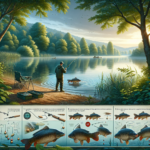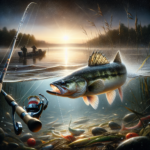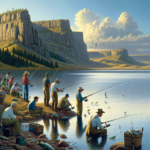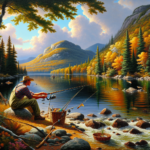Fishing Tips on How to Catch Carp

Introduction
Carp are a popular target for anglers around the world, known for their size, strength, and the challenge they present. These fish are not only a staple in sport and recreational fishing but also play a significant role in various cultures and ecosystems. This article aims to provide comprehensive tips and techniques for catching carp, covering everything from their behavior and habitat to the best fishing gear and techniques.
Fish Species Overview
Description
Carp are large, freshwater fish that can be identified by their robust bodies, large scales, and barbels on either side of their upper jaw. They typically range in color from olive green to golden brown, with a lighter belly. Carp can grow to impressive sizes, often reaching lengths of up to 40 inches and weights exceeding 40 pounds.
Habitat
Carp prefer freshwater environments such as lakes, rivers, and ponds. They are highly adaptable and can also be found in brackish waters. Common regions where carp are found include Europe, Asia, and North America. They thrive in areas with abundant vegetation and muddy bottoms, which provide ample food and cover.
Behavior
Carp are omnivorous and have a varied diet that includes aquatic plants, insects, crustaceans, and detritus. They are most active during the early morning and late evening hours. Spawning typically occurs in the spring when water temperatures reach around 18-20°C (64-68°F). During this time, carp can be seen in shallow waters, making them more accessible to anglers.
Challenges
One of the main challenges in carp fishing is their wariness and sensitivity to disturbances. Carp have excellent senses of smell and taste, making them cautious feeders. Additionally, their strong and powerful runs can make landing them a test of skill and patience.
Best Time to Catch Carp
Seasonal Considerations
The best time to catch carp is during the warmer months, from late spring to early autumn. During this period, carp are more active and feed more aggressively. The peak months are typically May through September.
Time of Day
Carp are most active during the early morning and late evening hours. Fishing during these times increases the chances of encountering feeding carp. Night fishing can also be productive, especially during the warmer months.
Weather Conditions
Ideal weather conditions for carp fishing include overcast skies and calm waters. Carp are more likely to feed actively on cloudy days, as they feel less exposed to predators. Mild temperatures and stable weather patterns also contribute to better fishing conditions.
Top Fishing Techniques for Carp
Technique 1: Bottom Fishing
Bottom fishing is one of the most effective techniques for catching carp. This method involves using a weighted rig to present bait on the lake or riverbed. Carp are natural bottom feeders, making this technique highly effective. Use a hair rig with boilies, corn, or pellets as bait to increase your chances of success.
Technique 2: Float Fishing
Float fishing is another popular method for targeting carp. This technique involves suspending bait at a specific depth using a float. It allows for precise bait placement and is particularly effective in shallow waters or areas with dense vegetation. Bread, worms, and maggots are excellent bait choices for float fishing.
Technique 3: Surface Fishing
Surface fishing, or “stalking,” involves presenting bait on the water’s surface to entice carp to feed. This technique is especially effective during warm weather when carp are more likely to feed near the surface. Use floating baits such as dog biscuits, bread, or artificial flies to attract carp.
Pro Tips
- Pre-baiting: Introduce bait to your fishing spot a day or two before fishing to attract carp to the area.
- Stealth: Approach your fishing spot quietly and avoid making sudden movements to prevent spooking the fish.
- Patience: Carp fishing often requires patience. Allow the fish time to investigate and take the bait before setting the hook.
Recommended Gear for Catching Carp
Fishing Rod and Reel
For carp fishing, a medium to heavy action rod with a length of 10-12 feet is ideal. This provides the necessary strength and leverage to handle large carp. Pair the rod with a robust spinning or baitcasting reel with a smooth drag system to manage the powerful runs of carp.
Fishing Line
Use a strong and durable fishing line with a breaking strength of 15-30 pounds. Braided lines are preferred for their strength and sensitivity, while fluorocarbon lines offer excellent abrasion resistance and low visibility in the water.
Hooks and Baits
Choose hooks in sizes 4 to 8, depending on the size of the bait and the carp you are targeting. Popular baits for carp include boilies, corn, pellets, bread, and worms. Experiment with different baits to determine what works best in your fishing location.
Additional Gear
- Bobbers: Use bobbers to keep your bait at the desired depth when float fishing.
- Sinkers: Add sinkers to your rig to ensure your bait reaches the bottom when bottom fishing.
- Landing Net: A large landing net is essential for safely landing and handling carp.
- Bite Alarms: Bite alarms can alert you to a carp taking your bait, especially useful during night fishing.
Best Locations to Find Carp
General Locations
Carp can be found in a variety of freshwater environments, including lakes, rivers, ponds, and reservoirs. They prefer areas with abundant vegetation, submerged structures, and muddy or sandy bottoms.
Specific Regions
Some popular regions known for carp fishing include:
- Europe: The UK, France, and Germany are renowned for their carp fisheries.
- North America: The Great Lakes, Mississippi River, and various reservoirs in the United States and Canada.
- Asia: China and Japan have a long history of carp fishing, with many well-stocked lakes and rivers.
Common Mistakes to Avoid
Mistake 1: Using the Wrong Bait
Using inappropriate or low-quality bait can significantly reduce your chances of catching carp. Always use fresh, high-quality bait that is known to attract carp in your fishing area.
Mistake 2: Overlooking Pre-baiting
Pre-baiting is a crucial step in carp fishing that many anglers overlook. Introducing bait to your fishing spot before you start fishing can attract carp and increase your chances of success.
Mistake 3: Ignoring Weather Conditions
Weather conditions play a significant role in carp behavior. Ignoring factors such as temperature, wind, and cloud cover can lead to unproductive fishing sessions. Always check the weather forecast and plan your fishing trips accordingly.
Catch and Release Tips
Importance of Conservation
Practicing catch and release is essential for maintaining healthy carp populations and ensuring sustainable fishing practices. It helps preserve the species for future generations of anglers.
Proper Handling Techniques
- Wet Your Hands: Always wet your hands before handling carp to protect their slime coat.
- Use a Landing Mat: Place the carp on a soft, wet landing mat to prevent injury.
- Minimize Air Exposure: Keep the carp out of the water for as short a time as possible.
- Support the Fish: Use both hands to support the carp’s body when lifting it.
Legal Considerations
Be aware of local fishing regulations, including size limits, bag limits, and protected areas. Always follow these regulations to ensure ethical and legal fishing practices.
Frequently Asked Questions (FAQs)
What is the best bait for catching carp?
The best bait for catching carp varies depending on the season, water conditions, and local preferences. Commonly used baits include boilies, corn, pellets, bread, and worms. Experiment with different baits to determine what works best in your fishing location.
Where is the best place to fish for carp?
Carp are commonly found in freshwater environments such as lakes, rivers, ponds, and reservoirs. Look for areas with abundant vegetation, submerged structures, and muddy or sandy bottoms. Popular carp fishing regions include the UK, France, Germany, the Great Lakes, and the Mississippi River.
What time of day is best for catching carp?
The best time of day to catch carp is during the early morning and late evening hours when they are most active. Night fishing can also be productive, especially during the warmer months.
What type of fishing line should I use for carp?
Use a strong and durable fishing line with a breaking strength of 15-30 pounds. Braided lines are preferred for their strength and sensitivity, while fluorocarbon lines offer excellent abrasion resistance and low visibility in the water.
Do I need a special fishing license to catch carp?
Fishing license requirements vary by location. Check with local authorities to determine if you need a special license or permit to catch carp. Be aware of size limits, bag limits, and any protected areas in your fishing location.
What is the best technique for catching carp?
The best technique for catching carp depends on the fishing conditions and personal preference. Bottom fishing, float fishing, and surface fishing are all effective methods. Experiment with different techniques to find what works best for you.
Are there any specific weather conditions that improve the chances of catching carp?
Carp are more likely to feed actively on overcast days with calm waters. Mild temperatures and stable weather patterns also contribute to better fishing conditions. Avoid fishing during extreme weather conditions, such as heavy rain or strong winds.
Can I catch carp from the shore, or do I need a boat?
Carp can be effectively caught from both the shore and a boat. Shore fishing is often more accessible and allows for stealthy approaches. Boat fishing provides access to deeper waters and less accessible areas. Choose the method that best suits your fishing location and preferences.
How can I improve my chances of landing a big carp?
To increase your chances of landing a big carp, use high-quality bait, fish during peak activity times, and target areas known for large carp. Pre-baiting your fishing spot and using strong, reliable gear will also improve your chances of success.
What should I do if I plan to release carp after catching them?
If you plan to release carp after catching them, practice ethical catch and release techniques. Wet your hands before handling the fish, use a landing mat, minimize air exposure, and support the fish’s body when lifting it. Follow local regulations and guidelines for catch and release practices.
Conclusion
Carp fishing is a rewarding and challenging pursuit that requires knowledge, skill, and patience. By understanding the behavior and habitat of carp, using the right gear and techniques, and practicing ethical fishing practices, you can increase your chances of success. Whether you are a seasoned angler or a beginner, these tips will help you catch more carp and enjoy the thrill of this popular sport. So grab your gear, head to your favorite fishing spot, and put these tips into practice. Happy fishing!




